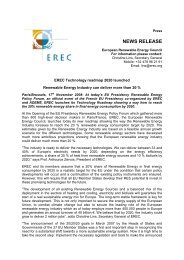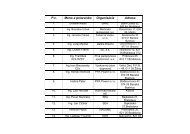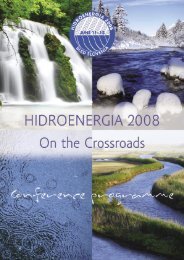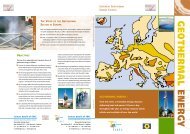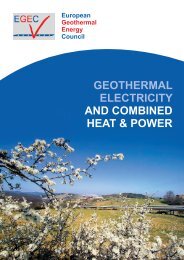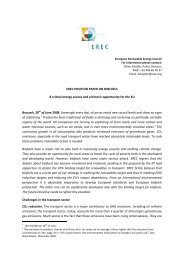CTO Assessment - European Commission
CTO Assessment - European Commission
CTO Assessment - European Commission
Create successful ePaper yourself
Turn your PDF publications into a flip-book with our unique Google optimized e-Paper software.
Action Plan for Large<br />
Scale Deployment of<br />
RES in Crete<br />
Contact: Dr. Nikolas Zografakis •Regional Energy Agency of Crete<br />
Kountourioti Sq. • 712 02, Heraklion • Crete • Greece<br />
Tel: +30 81 224 854 • Fax: +30 81 343 873<br />
E-mail: enrg_bur@crete-region.gr<br />
Crete is fourth largest island in the<br />
Mediterranean, with an area of 8335 km 2 .<br />
Tourism is the most dynamic activity in the<br />
island (more than 3 millions tourists in<br />
2000) and economic growth rates double<br />
the national average.<br />
Because of a net increasing population<br />
trend in recent years, of a high growth rates<br />
in economy, as well as of fast development<br />
of a tertiary sector (mainly the seasonal<br />
tourism), Crete faces problems of high<br />
rates of electricity and mainly of power<br />
demand (8% per year compared to 4% of<br />
the national average). Additionally there<br />
is a reluctance of the population to accept<br />
the installation of new thermal power<br />
stations.<br />
For the above reasons, the project of largescale<br />
RES development has a particular<br />
importance in Crete, where it exemplifies<br />
an important part of the island issues.<br />
The initiative<br />
The Region of Crete – through the<br />
proposals of its Regional Energy Agency –<br />
has adopted since 1999 an integrated<br />
energy policy and programming, which<br />
gives particular emphasis on the RES and<br />
RUE promotion and implementation.<br />
The Regional Energy Agency of Crete and<br />
the National Technical University of<br />
Athens have formulated the<br />
“Implementation Plan for RES in Crete”.<br />
The defined Implementation Plan for the<br />
period 1998 – 2010 is focused on the<br />
exploitation of RES for electricity<br />
production, is formulated on the basis of<br />
available RES potential, on the technical<br />
constraints for the RES penetration and<br />
on the existing legislative framework.<br />
The objectives of the Implementation Plan<br />
are:<br />
to cover the additional electricity demand<br />
in a sustainable way<br />
to cover the maximum average net hourly<br />
production,<br />
to provide the electrical system with an<br />
adequate safety margin<br />
to require the minimum interventions to<br />
the existing grid, and<br />
to use the most mature and cost-effective<br />
RES technologies.<br />
Short-term actions refer to the period<br />
1998-2005 and medium-term actions to<br />
the period 2005-2010. The plan promotes<br />
electricity production by exploiting several<br />
RES technologies (wind farms, biomass,<br />
small hydroelectric units, photovoltaic<br />
installations, pumped storage units) at a<br />
maximum possible penetration rate in<br />
order to cover the increase of electricity<br />
demand. Moreover it suggests additional<br />
actions among at electricity savings (solar<br />
hot water systems, replacement of<br />
incandescent bulbs, passive and hybrid<br />
systems for cooling, time-zone pricing<br />
system, etc.). The strategy of the Action<br />
Plan is complemented by a number of<br />
initiative regarding demand side<br />
management for the period 1998-2010,<br />
with a special incidence in the tourist and<br />
Electricity Production<br />
Maximum figures<br />
Energy demand (GWh)<br />
1. Conventional<br />
2. RES<br />
2.1.Wind Parks<br />
2.2. Biomass Units<br />
2.3. Small Hydro-Electric Units<br />
2.4. Photovoltaic Installations<br />
2.5. Pumped Storage Units<br />
Safety Margin<br />
Total non-intermittent sources (MW)<br />
Mean Net Power of Conventional Units(MW)<br />
Mean Net Power of RES (MW)<br />
1. Wind parks (MW)<br />
2.Biomass units with agricultural by products (MW)<br />
3. Small Hydro-Electric units (MW)<br />
4. Photovoltaic installations (MW)<br />
5. Pumped-Storage units (MW)<br />
residential sectors.<br />
With the implementation of this plan the<br />
total RES electricity production could<br />
reach 39.4% in 2005 and 45.4% in 2010.<br />
Enabling factors<br />
The region of Crete has developed an<br />
energy policy, which has been unanimously<br />
approved by the Regional Council and has<br />
its full support, as well as the support of<br />
relevant national authorities: Ministries for<br />
Development and National Economy, and<br />
Public Power Corporation (PPC).<br />
Replication<br />
The Crete Action Plan was used as a model<br />
to start similar projects, especially those<br />
dealing with <strong>European</strong> island regions. At<br />
present Crete is working, together with<br />
other island territories, on a feasibility<br />
analysis for storage solutions that could<br />
allow increasing the rate of penetration of<br />
renewables, in particular with regard to<br />
wind-hydropower solutions.<br />
2000 2006 2010<br />
1,815 2,484 2,700<br />
1,470 1,508 1,474<br />
345 976 1,226<br />
223 499 624<br />
120 238 356<br />
2 25 27<br />
0.2 2 5<br />
0.0 211 213<br />
21% 36% 20%<br />
491 717 776<br />
469 546 585<br />
110.2 373 445<br />
89.3 200 250<br />
20 40 60<br />
0.6 6 6<br />
0.2 2 4<br />
— 125 125<br />
<strong>CTO</strong> - Showcase<br />
87


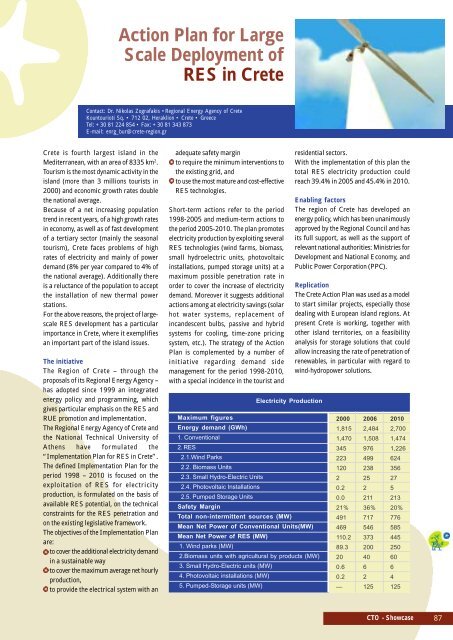
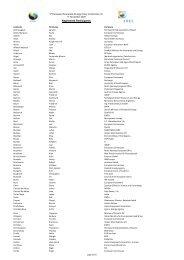
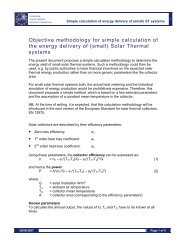

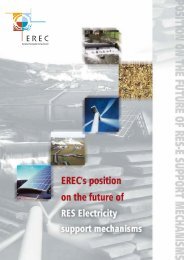

![Energy [R]evolution - Greenpeace](https://img.yumpu.com/47174859/1/184x260/energy-revolution-greenpeace.jpg?quality=85)
